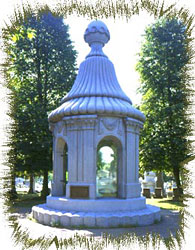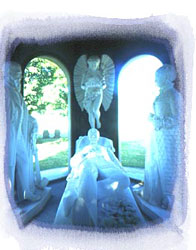|
 It's
impossible to stroll by the Blocher mausoleum in Buffalo’s Forest
Lawn Cemetery without wondering what the story is behind this one-of-a-kind
tomb. Indeed, the circumstances that led to the tomb’s construction
are an intriguing mix of fact and fable. It’s a tale of love and
passion and loss and sorrow. It's
impossible to stroll by the Blocher mausoleum in Buffalo’s Forest
Lawn Cemetery without wondering what the story is behind this one-of-a-kind
tomb. Indeed, the circumstances that led to the tomb’s construction
are an intriguing mix of fact and fable. It’s a tale of love and
passion and loss and sorrow.
The center of attention inside the tomb is Nelson Blocher, laid out
for viewing, clutching a bible. Looking at his prostate form are his
parents, John and Elizabeth Blocher. Hovering above is an angel, who,
some say, bears a striking resemblance to a maid employed by the Blocher
family. It’s said that Nelson died of a broken heart. Accounts
of the day say that his mother, Elizabeth, goaded her husband, John
into constructing the tomb as a memorial for their heartbroken son.
John Blocher was born in 1825 in the small town of Scipio, New York.
At age 10, he became “the man of the family” following the
death of his father. This left him with little formal education, but
the adult responsibilities that he assumed at a young age charged him
with entrepreneurial spirit. At age 18, he opened a tailoring business
in Buffalo, which he soon developed into a general store, supplying
ready made clothing, dry goods and groceries to Buffaloans. At age 20,
John married 19 year old Elizabeth Neff. The union produced one son,
Nelson, who was born in 1847.
John Blocher enlisted in the Union Army at the outbreak of the Civil
War, and served one year in the 78th New York Regiment, before being
discharged for ill health. Returning to Buffalo after his stint in the
army, Blocher turned the war to his advantage and proceeded to manufacture
shoes and boots for the army. His prosperous footwear business and some
shrewd real estate investments soon turned John Blocher into one of
Buffalo’s wealthiest citizens. Fittingly, he installed his family
in an elegant residence on Delaware Street, Buffalo’s answer to
Manhattan’s Fifth Avenue.
The Blocher residence, of course, needed the usual compliment of servants.
One young maid in particular, 20 year old Katherine, ultimately became
the force behind the construction of the Blocher mausoleum. And herein
lies the tale.
It seems that Nelson Blocher either wasn’t inclined toward marriage
or was inept at the social skills necessary to secure a bride. Not only
was he still a bachelor at age 34, he was living at home. Nelson made
frequent buying trips to Europe to purchase leather goods for the family
business and art and furniture for the family home. But, when he returned
to Buffalo, he was assigned to the rather mundane day to day duties
of attending to the Blocher business.
Then one day, in the spring of 1881, the Blochers hired a new maid.
Katherine was 20 years old, pretty and unattached. Nelson was immediately
smitten and made no attempt to hide it. During the spring and summer
of 1881, he found ways to be near Katherine and to spend time with her.
There is reference to an injured kitten Nelson and Katherine nursed
back to health. Some say that Katherine wasn’t particularly attracted
to Nelson but encouraged and continued the flirtation to keep her job,
while others say they fell in love. But, whatever the case, it’s
clear that it simply wasn’t proper for a well bred man about town
to consort with a lowly maid, no matter how charming she may be.
Nelson’s parents did not approve of the romance and quickly made
plans to put an end to it. In the fall of 1881, Nelson’s father
John announced that there was business to be attended to in Europe and
Nelson needed to make plans to leave for an extended trip. Plainly,
Nelson’s father wanted to separate the couple and put an end to
the romance. One story says that Nelson proposed marriage to Katherine
on the eve of his departure to Europe, but Katherine said she needed
time to think, while other accounts say that Nelson barely had time
to say good-bye.
After Nelson left for Europe, one account says that Katherine had second
thoughts about marriage and used the opportunity to depart for parts
unknown. But a more accepted account says that immediately after Nelson’s
departure, the Blochers fired Katherine with a strict admonition never
to return. What is true, however, is that in the spring of 1882, when
Nelson returned from his travels, Katherine was gone and nobody seemed
to know where she went. John and Elizabeth Blocher told their son that
two weeks after Nelson left for Europe, Katherine had stealed away in
the middle of the night, leaving nothing behind but her bible.
Whatever the reason for Katherine’s departure, Nelson was heartbroken.
He couldn’t believe she had left without even leaving a note. There
must have been a reason and he was determined to find her and convince
her to come back. Throughout the remainder of 1882 he searched for her.
And like the lovelorn for eons before him, he neglected his business
and health in pursuit of love. By the fall of 1883, Nelson was tired
and wornout from his search. Broken in spirit and sick with a fever,
Nelson took to his bed. By early winter of 1884 he was drifting in and
out of sickness and depression. Soon he became bedridden. His only solace
was the bible Katherine had left behind. Then on January 24th, 1884
Nelson’s time in this realm was over. He died with Katherine’s
bible clutched to his breast.
Nelson’s mother, Elizabeth, no doubt driven by a maternal blend
of love and guilt, insisted that a suitable memorial be erected to her
son. The task of designing the monument would fall to the creative hand
of John Blocher. At the time of Nelson’s death, John Blocher was
semi-retired. He had taken up sculpting as a hobby and would use those
skills in designing the Blocher monument.
 The
spirit of the Blocher monument belongs to an architectural style all
its own. The closest category of architecture that the Blocher mausoleum
can be compared to, is the “follies” of 19th century Victorian
architecture. A folly is defined by Penguin’s Dictionary of
Architecture as “A costly, but useless structure built to satisfy
the whim of some eccentric and thought to show his folly...” The
spirit of the Blocher monument belongs to an architectural style all
its own. The closest category of architecture that the Blocher mausoleum
can be compared to, is the “follies” of 19th century Victorian
architecture. A folly is defined by Penguin’s Dictionary of
Architecture as “A costly, but useless structure built to satisfy
the whim of some eccentric and thought to show his folly...”
Supposedly, John Blocher just couldn’t find a monument designer
to correctly interpret his vision, so without any formal training in
construction, he took it upon himself to craft the mausoleum.. Blochers
design which looks more like an elaborate confection rather than a mausoleum,
may have been ahead of its time. Nowadays, it would be easy to imagine
a structure like the Blocher mausoleum gracing an avenue of pillowy
shaped buildings in Toontown in Disneyland.
Blocher had two elements to design. The first design was for the exterior
of the mausoleum. The other design was for statues of the Blocher family
and an angel (which some folks say looks a lot like the maid) which
would be sealed behind glass in the mausoleum’s interior. He contracted
with the firm of John McDonnell to cut and assemble the pieces of the
mausoleum from quarries in Quincy, Massachusetts. Blocher ingeniously
designed the mausoleum so that the entire structure could be built with
only twenty stones; thus minimizing maintenance problems. The roof,
which is frequently a maintenance nightmare in stone structures, is
formed by just one piece, a bell shaped affair. Another stone, shaped
like a ball, is used for the cap stone. The bell was cut from a 90 ton
slab of granite and whittled down to 29 tons. It is supported by five
pilasters.
The pieces of the mausoleum were hoisted into position by massive rigging
equipment. All of the elements were precisely set in place. But as the
ball, the tomb’s crowning glory, was being lowered into its nest
at the top of the bell, the timbering gave way and the ball came crashing
down cracking the bell. A lawsuit ensued; the contractor claimed that
Blochers design was at fault, resulting in an inherently weak structure.
Blocher claimed that it was a simple case of negligence. Eventually
Blocher prevailed and another bell was manufactured. The capstone was
finally, ever so gently, lowered into place without incident.
In the openings between the pilasters, Blocher specified four one inch
thick panes of glass, which were manufactured in Paris and another one
inch thick piece of glass with hidden hinges that serves as a door.
Before the mausoleum was assembled, work had already begun on the statuary.
For the statues on the inside of the mausoleum, Blocher originally
commissioned Paul Roche of Westerly, Rhode Island to come to Buffalo
and carve the statues out of Carrara Marble.. Blocher fashioned a plaster
model of Nelson Blocher lying on a couch and instructed Roche to carve
a life size replica. Roche chiseled away under John Blochers constant
supervision, but Blocher was less than pleased with Roche’s carving
skills. In fact, when Roche unveiled the finished sculpture, Blocher
took an axe to it and chopped it to pieces.
After sending Roche packing, Blocher contracted with noted artist Swiss
born, Italian sculptor, Frank Torrey in Carrara, Italy. Torrey wasn’t
about to travel to Buffalo, so Blocher supplied the sculptor with photographs,
models and measurements of Nelson, Elizabeth and himself.
For close to three years, Torrey toiled away, chiseling and shaping
the statues. They were finally completed in 1888 and shipped to Buffalo
where they were installed in the mausoleum.
The first resident of the mausoleum was Nelson, who had spent the years
since his death in the cemetery’s receiving vault. Following him
were his mother, Elizabeth Neff Blocher, who died of pneumonia at age
78 on March 31, 1904 and John Blocher, who died of “old age”
on June 30, 1911 at the age of 85.
But where exactly are the Blochers spending eternity? They are underneath
a movable slab in the floor of the mausoleum. According to a Buffalo
newspaper report published when the mausoleum was being built, there
are six crypts. This story led to a rumor that, in the safe of the cemetery
office, there is a quit claim deed stating that one of the other crypts
is reserved for Margaret Katherine Sullivan—the maid. This story
became fodder for romantic stories—that often ran around Valentine’s
Day— suggesting that although the love struck Nelson could not
have Katherine in life there was still a possibility he might spend
eternity with her.
Alas, Forest Lawn management tells us that there are only three crypts
below the Blochers’ marble likenesses. Poor Nelson is spending
eternity just as he did in life—with his parents. The whereabouts
of the maid in unknown.
|